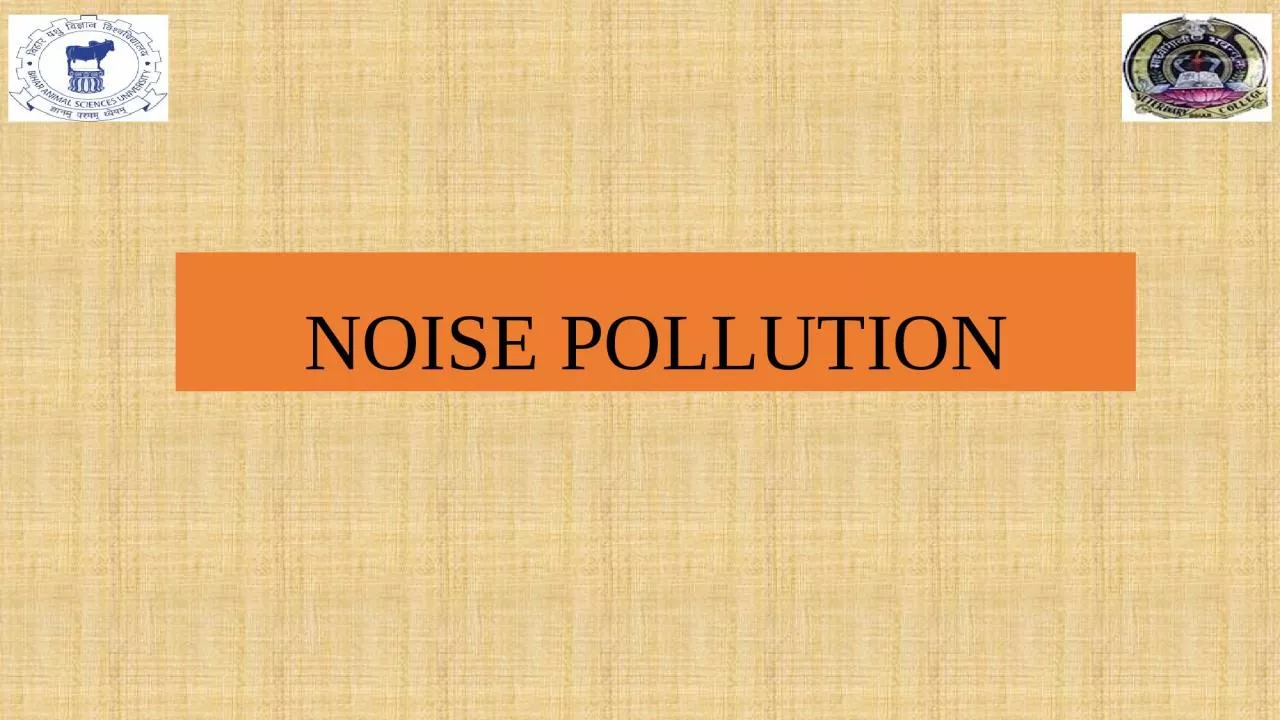

The threat of noise pollution is increasing with the rapid pace of urbanization and industrialization Unwanted sounds not only cause discomfort and irritability to animals but can also lead to ID: 1018173
Download Presentation The PPT/PDF document "NOISE POLLUTION Noise is defined as an u..." is the property of its rightful owner. Permission is granted to download and print the materials on this web site for personal, non-commercial use only, and to display it on your personal computer provided you do not modify the materials and that you retain all copyright notices contained in the materials. By downloading content from our website, you accept the terms of this agreement.
1. NOISE POLLUTION
2. Noise is defined as an unwanted or undesirable sound. The threat of noise pollution is increasing with the rapid pace of urbanization and industrialization. Unwanted sounds not only cause discomfort and irritability to animals but can also lead to physiological disturbances. The noise level can be measured with the help of a sound level meter.
3. SOURCES AutomobilesFactoriesIndustriesAir-craftVehicle HornsLoudspeakerRadiosTransistorsTelevision etc.
4. PROPERTIESThe noise has two important properties: loudness or intensity and frequency. Loudness or intensity depends upon the amplitude of the vibrations which initiated the noise. The loudness of noise is measured in decibels (dB). When we say that the sound is-----dB, it means it is-----dB more intense than the smallest distinguishable noise or the reference sound pressure.0.0002 microbar or dynes/cm2; dyne is 1/1000000th of atmospheric pressure.
5. A daily exposure up to 85 dB is the tolerable limit without substantial damage of hearing. Normal conversation produces a noise of 60-65 dB. Whispering produces a noise of 20-30 dB.Heavy street traffic produces a noise of 60-80 dB.Boiler factories produces a noise of about 120 dB. In dairies the usual noise levels are found to range between 60-64 decibels. In dairies with fan ventilation the levels may reach more than 80 decibels. In piggeries (especially during feeding) the noise can reach levels of about 100 decibels or more.
6. Noise level of 50 dB represents calm environment. Noise level of a living room in terms of activity is 40-50 dB. A level of 140 decibel (airplane sound) causes pain in the ear.Excessive sound levels (160-180 dB) may even cause ear damage. In case of humans noise beyond 115 decibels is not permitted. Sound level of 100 decibels for 2 hr and 90 for 8 hr is acceptable.
7. The frequency of noise is denoted as Hertz (Hz).One Hz is equal to one wave per second.The human ear can hear frequencies from about 20-20,000 Hz.The range of vibrations below 20 Hz is infra- audible and those above 20,000 Hz ultra-sonic. Many animals (dogs) can hear sounds inaudible to the human ear.Sometimes noise is expressed in psycho-acoustic terms- the phon (psyho-acoustic index of loudness).It takes into consideration both intensity and frequency.
8. INSTRUMENTS USED IN NOISE STUDIESSound level meter: Measures intensity of sound in decibel ie. dB or sound pressure levels ie. dB(A).Octave band frequency analyzer: Measures noise in octave bands and resulting plot shows sound spectrum ie. High pitch, low pitch or variable pitch.Audiometer: Measures hearing ability.
9. EFFECTS OF NOISE EXPOSURE AUDITORY & NON-AUDITORYAuditory effects: Auditory fatigue (appears at 90 db & greatest at 4000Hz) associated with side effect of whistling and buzzing in ears. Deafness or hearing loss (temporary loss at frequency 4000 – 6000 Hz and permanent loss at continuous exposure to 100 dB).Permanent loss of hearing is due to inner ear damage ie. minor change in hair cell ending to destruction of organ of corti at 100 dB.Rupture of tympanic membrane on exposure at 160 dB.
10. Non auditory effect:Interference with speech: most common at frequency 300-400 Hz.Annoyance/irritationReduce efficiency of workPhysiological change: rise in blood pressure, intracranial pressure heart rate, breathing and sweating. Other health effects include giddiness, nausea, fatigue, visual disturbances. stress, hormonal disturbances, cardiovascular problems and muscular rigidity. In poultry the egg production is seriously affected and in animals behaviour may change.
11. CONTROL OF NOISECareful planning of citiesControl of vehiclesImprovement in acoustic insulation of buildingCare in installations of industries and railwaysProtection of exposed personLegislationEducation
12. Thanks